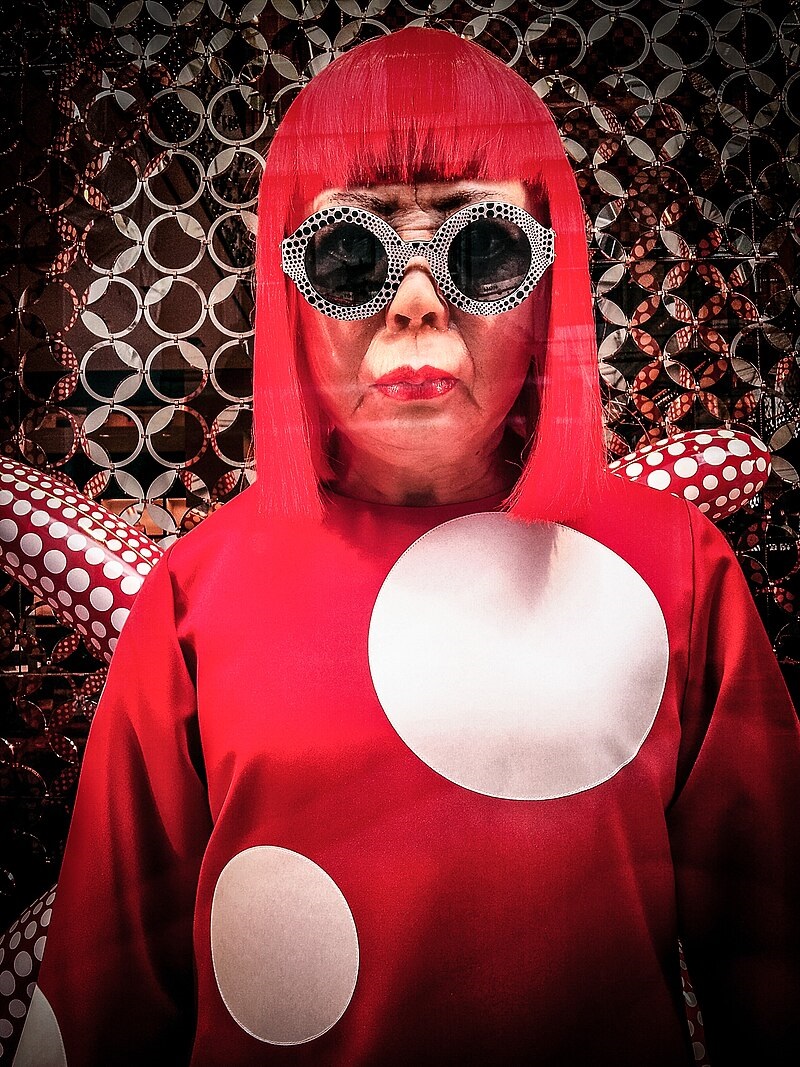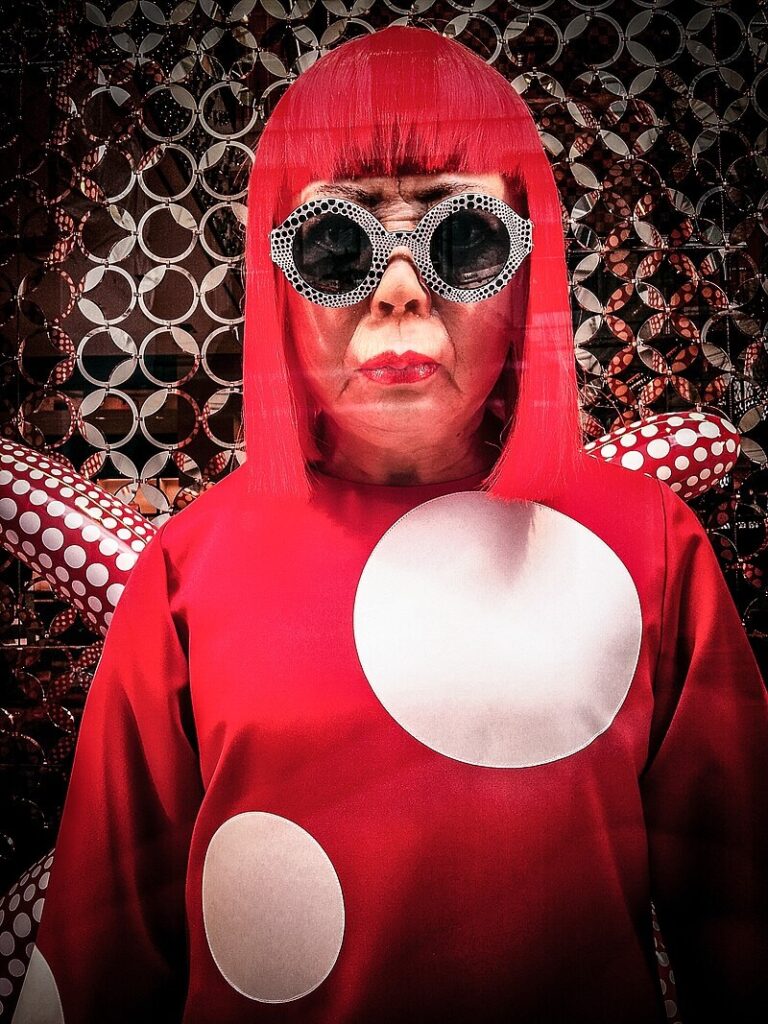- Humanities
- 17 de September de 2024
- No Comment
- 8 minutes read
Yayoi Kusama: Exploring the Boundaries of Art

Yayoi Kusama: Exploring the Boundaries of Art
Intercultural dialogue as a catalyst for artistic innovation


Marta Ferré
The interaction between Eastern and Western cultures has historically served as a boundless wellspring of inspiration and transformation within the spheres of culture and art. This cross-cultural exchange, as defined by Argentine anthropologist Néstor García Canclini, is the process of melding two distinct cultures to create new, hybrid forms. With the advent of globalisation, driven by global technological advancements, this exchange has only intensified.
While some critics argue that globalisation may lead to the homogenisation and fragmentation of identities, it is equally important to acknowledge its potential to connect and rejuvenate cultures through these interactions. Indian theorist Homi K. Bhabha posits that such exchanges generate a fertile “interstitial” space where new identities and artistic practices emerge, mirroring the complexities of our contemporary world.
A prime illustration of this dynamic is Yayoi Kusama, a Japanese multidisciplinary artist whose prolific career spans decades. At 95, and voluntarily residing in a psychiatric hospital, Kusama continues to create with tireless dedication. Her art is marked by repetitive motifs, such as polka dots—randomly placed on various surfaces—which reflect traditional Japanese ukiyo-e art, and a vibrant use of colour. The melding of traditional Japanese aesthetics with avant-garde Western influences has led to the creation of uniquely impactful works. Kusama’s oeuvre exemplifies how intercultural dialogue can act as a catalyst for artistic innovation.
Under the Oppressive Environment of Patriarchal Japan
Born in 1929 in Matsumoto, Japan, into a conservative family engaged in seed and nursery trading, Kusama grew up amidst fields and flowers. From an early age, she demonstrated exceptional artistic talent and began experiencing hallucinations involving lights, dots, and flowers speaking to her, which led to mental health struggles. Her tumultuous childhood, marked by a mother who coerced her into spying on her father’s infidelities, instilled in her a lasting phobia of sex and men. These personal struggles are reflected in some of her works, such as the installation Infinity Mirror Room-Phalli’s Field (1965).
During the 1930s and 1940s, Japan underwent profound transformations under Emperor Hirohito’s Shōwa era (1926-1989). Post-World War II, the nation experienced rapid reconstruction under American occupation, known as the “economic miracle”, which opened Japanese society to Western influences. Although the 1947 constitution promised gender equality, rural women continued to face significant barriers, traditionally restricted to roles of daughter, wife, and mother, adhering to Confucian principles.
In this patriarchal environment, Yayoi Kusama defied her parents’ social and gender-related objections to pursue an artistic career. After enrolling at Kyoto University of Arts to study Nihonga, traditional Japanese painting, she felt constrained by this style and shifted towards avant-garde art and European and American abstract impressionism. Her early exhibitions between 1950 and 1957 in Japan captivated art critics, though often accompanied by ambivalent and dismissive commentary influenced by gender biases.
Determined to preserve her creative essence and explore opportunities abroad, Kusama left Japan, seeking to express herself freely. Her arrival in New York in the 1960s marked a pivotal moment in her career.
New York Becomes the Epicentre of Contemporary Art
The 1960s in the United States was a period of seismic shifts in society, politics, and culture. This era was marked by John F. Kennedy’s presidency, the Cuban missile crisis, the space race culminating in the moon landing of 1969, and the Vietnam War. Following Kennedy’s assassination, Lyndon B. Johnson advanced the Great Society programme, including reforms to the 1964 Civil Rights Act aimed at ending racial discrimination. Key figures such as Martin Luther King Jr., with his renowned “I Have a Dream” speech, and Malcolm X emerged as leading voices in the civil rights movement for African Americans.
Simultaneously, the 1960s counterculture took shape, advocating feminism with figures like Betty Friedan and her book The Feminine Mystique (1963), sexual liberation with the introduction of the contraceptive pill in 1961, and the defence of freedom of expression, LGBT+ rights, and visibility. The hippie movement embraced freedom, rejected consumerism, and highlighted ecological awareness and the use of psychedelic drugs.
This cultural revolution mirrored an innovative and transgressive spirit of the times. Icons like Allen Ginsberg, Jack Kerouac, and bands such as The Beatles, The Rolling Stones, Jimi Hendrix, Janis Joplin, and The Velvet Underground defined the counterculture with their psychedelic music and rebellious messages. Concurrently, New York emerged as the epicentre of global contemporary art, experiencing a surge of diversity and creativity driven by movements like pop art, abstract expressionism, minimalism, conceptual art, Fluxus (everything that flows), performance art, graffiti, and street art. Immersed in this vibrant scene, Kusama engaged with artists such as Georgia O’Keeffe, Donald Judd, Joseph Cornell, Willem de Kooning, and Andy Warhol, with whom she had both admiring and contentious relationships, accusing Warhol of appropriating some of her ideas.
Amidst this bustling environment, Kusama found New York to be a stage full of challenges and opportunities. Initially marginalised as an outsider in a predominantly male-dominated art world, her immersive installations and repetitive motifs made a significant impact. Embracing feminism, she challenged gender stereotypes by incorporating sexual symbols and everyday objects into her sculptures. Her performances and happenings conveyed political messages against the Vietnam War and other social issues, establishing her as a prominent figure in the hippie culture and sexual liberation movements.
Kusama’s exceptional engagement with her artistic and social milieu, so distinct from her Japanese context, facilitated her creative exploration across disciplines such as painting, sculpture, photography, infinity installations, happenings, performances, body painting, and video art. Her determination and energy were crucial in establishing her as a leading figure in New York’s artistic avant-garde, while maintaining a distinctive Japanese identity in her creations.
A Key Figure in Contemporary Artistic Avant-garde
Upon returning to Japan in 1973, Kusama organised several happenings, including a notable Tokyo event where she appeared half-naked to protest sexual repression, resulting in her arrest and press censorship. Although Kusama fell into obscurity during the 1970s and 1980s, her work was rediscovered in the late 1980s through exhibitions in New York and Venice, reigniting her international acclaim.
Since then, Kusama’s involvement in international events has continued to rise, cementing her status as a pivotal figure in the contemporary artistic avant-garde and a cultural icon of the 21st century. She is currently the highest-valued living artist globally, with published novels, poetry, and an autobiography. Additionally, she has a museum in Tokyo dedicated to her work, the Yayoi Kusama Museum, and has designed fashion collections in collaboration with brands such as Gucci or Louis Vuitton.
Kusama’s example underscores that art and culture are dynamic and perpetually evolving, nurtured by exchanges between diverse traditions and perspectives. Her work continues to inspire new generations to explore uncharted territories and embrace diversity as a wellspring of enrichment and creativity. Yayoi Kusama’s unique artistic vision, born from the cultural interaction between East and West, persists in creating new creative realms, ensuring her legacy endures infinitely.
Source: educational EVIDENCE
Rights: Creative Commons

